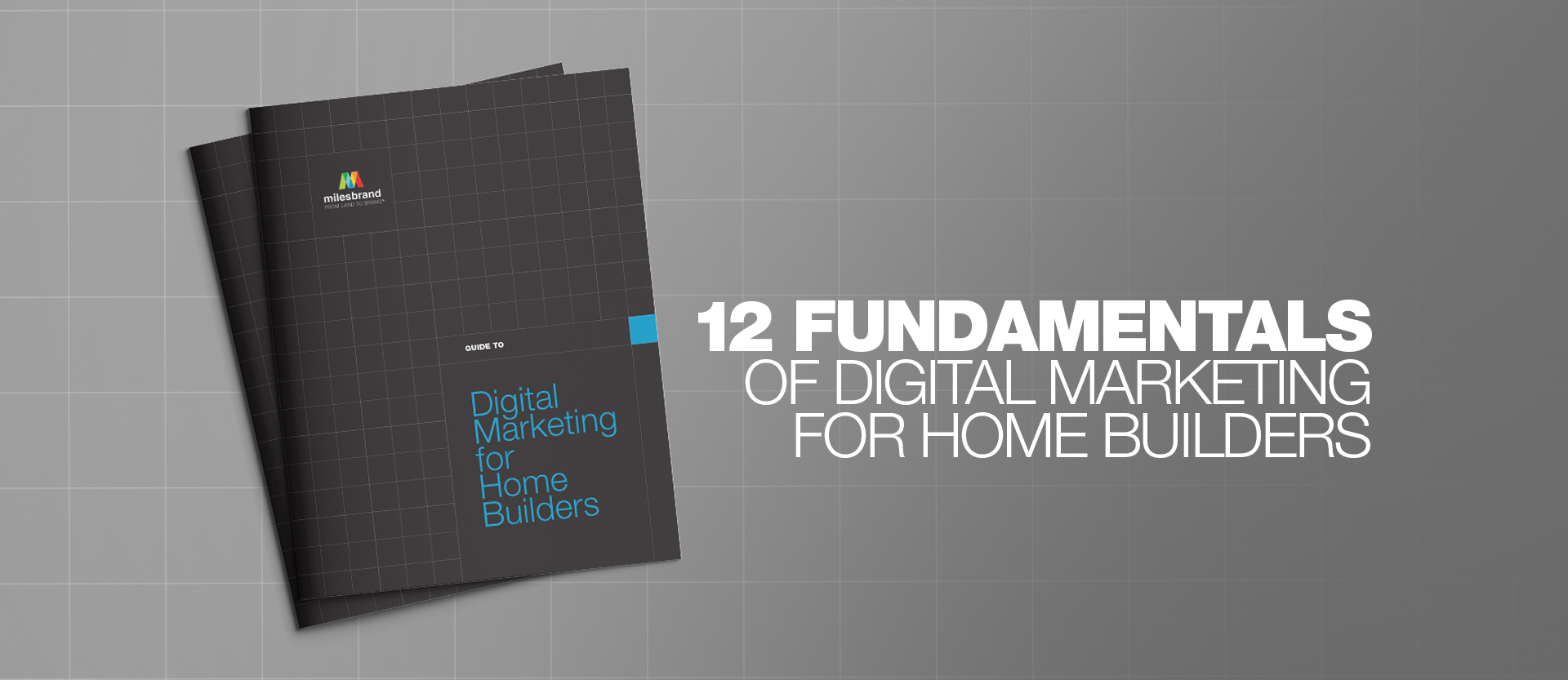March 19, 2021
12 Fundamentals of Home Builder Digital Marketing
At its core, marketing is about creating relationships with people and making them feel valued by your brand. Campaigns, emails, videos, images, blog posts — everything must work together to speak directly to a specific group of people and create emotional connections with them.
So, what does that mean for home builder marketing? Well, the need to produce great marketing — not just good — is magnified tenfold.
To market your homes effectively, you must operate under the belief that buying a home is among the most emotional and significant purchases a person will make in their lifetime. In turn, you have the responsibility of fulfilling that aspiration and ensuring you are the only home builder to make their biggest dream a reality.
However, many home builders struggle to use the latest trends in digital marketing to connect with their buyers. In the digital era, meeting your customers at a pivotal stage in the buyer’s journey is a must, and digital marketing accomplishes just that.
This guide will introduce the 12 most important components of real estate digital marketing so you can begin implementing modern digital tactics into your home builder marketing strategy.
Skip to a specific section below, or download the whole guide here.
DOWNLOAD GUIDE
TABLE OF CONTENTS
SEO & Content: The Organic Approach
Master Your Home Builder Digital Marketing Campaign
1. Why Digital?
Before discussing the different components of real estate digital marketing, we need to understand just how impactful digital marketing is for home builders. In simple terms, it all comes down to the modern buyer’s journey.
Modern homebuyers — and all shoppers, for that matter — don’t want to be sold to. They want to walk their way through the buyer’s journey in a manner that is conducive to their needs and interests, not those of whoever is doing the selling.
And where is this shopping done? The internet.
More than 95% of homebuyers search for their home on the internet, and if you don’t have a digital presence as a home builder, you will get overlooked. With so many house hunters turning to the internet, this creates a great opportunity for home builders to build meaningful brands that evoke emotional responses from their clientele.
But what components make up a sound digital marketing strategy? What are the first steps to take? How do you execute and track a successful digital campaign? How do digital tactics vary for home builders?
Target Audience
The first component of a successful digital marketing campaign is identifying your ideal target audience. An intimate understanding of your buyer sets the stage for every other component of digital marketing.
Think about it this way: would you rather attract 100 unqualified buyers to your website or one qualified buyer? Don’t let the enticing number fool you. One homebuyer who comes across your home and realizes it is the ideal fit for their needs is far more beneficial than 100 people entering your site, realizing your homes are not their ideal fit, and leaving the site.
To attract that one specific buyer who is more likely to convert, you must create buyer personas that go beyond the surface-level demographics and actually understand their everyday struggles:
- Are they a first-time buyer, move-up buyer, or active-adult adult buyer?
- What specific things are they looking for in a home and community?
- How will your home help their family enjoy a better quality of life?
With these fictional representations of your buyer in place, you are better able to organize your campaigns to appeal to their exact needs.
2. Keyword Research
With the correct target audience identified, it’s time to put yourself in their shoes and consider what they would search for on Google to find the mix of homes you offer. Are you a build-on-your-lot builder who doesn’t sell new homes, or do you want to advertise yourself as a new home builder in a specific location?
Keyword research allows you to understand the exact phrases people are searching for on the internet and how frequently those terms are being searched so you can map your campaign around that language. When your website features these keywords on landing pages, blog posts, and other pages, your site will “rank” higher on Google, meaning it is more likely to show up when someone searches the specific term you are writing about.
There are two aspects of keyword research to consider, both of which we will discuss in more detail in further sections:
Organic: Organic search is a long-term, cost-effective investment.
PPC: PPC (Pay-Per-Click) search is a short-term, paid investment.
3. SEO & Content - The Organic Approach
Simply put, SEO (search engine optimization) is the process of adding relevant, engaging content throughout your website to improve the site’s visibility in search engines. SEO as a whole has come a long way since the keyword-stuffing days when search engines solely focused on keyword frequency.
Now, it spans everything from video to design to usability with one main parameter — how does your site improve customer experience? Yes, the goal of SEO is to make your site appear on the first page of Google when someone searches for a specific keyword you are targeting. But it’s what happens next that really matters.
When a person visits your site, they have to be rewarded. Whether it be an educational blog post, an entertaining video, or promotional downloadable, give them a reason to stay on your site and interact with your brand. There are five main steps to SEO and content:
- Target Audience — Revisit section one to learn the importance of identifying the right target audience.
- Keyword Research — Identify the keywords that you want to rank for based on how many people search for the term per month (SEMRush is a great keyword research tool). For example, if you’re a home builder in Colorado, a relevant term could be “Denver new home builder”.
- Keyword Organization — Keywords should be organized into different clusters, each cluster with one main keyword. The goal is to create content about supporting keywords with lower volume to rank for the main keyword per cluster that has a higher search volume.
- Content Planning — Based on the keywords you identify, create a content plan with relevant, engaging topics about each keyword you have identified. This content can include landing pages, blogs, downloadable content, video, and design elements.
- Content Linking — As you begin producing content, it’s imperative to link that content throughout your site. Blog posts within the same cluster should always link to one another, and there should be plenty of conversion opportunities throughout all pieces of content to create leads and ultimately, customers.
As we said above, SEO is a long-term strategy that requires time to produce. You can include pieces of content throughout your site for free, and the more you produce over time, the more likely you are to rank on search engines.
But what about the short-term opportunities available when you are trying to establish an organic presence?
4. Paid Search - The PPC Tactic
Paid search is to PPC as SEO is to organic. When executed correctly, SEO performs well over time while limiting costs. However, the truth is that you need to market your homes early in the process, before SEO can work its magic.
That’s where paid search comes into play. The goal is similar — ensuring your website shows up when someone searches for a specific term. Rather than developing a library of organic content over time with the goal of ranking for a specific keyword, you can actually pay to have your content published atop Google for the same keyword immediately.
As the name implies, PPC costs you a certain price every time someone clicks on the content. The cost varies per keyword, with high-search keywords costing more than low-search keywords.
Identifying the cost-per-click during keyword research is the first stage in mapping out a successful paid strategy. From there, you can create landing pages on specific keywords that are affordable as well as attainable and run a paid campaign that links to that landing page.
It’s also crucial to balance your paid and organic search strategy. The two should work in tandem with the paid campaign for a specific keyword providing immediate results while the SEO strategy for the same keyword builds over time.
5. Display Ads
Real estate display ads are another form of paid digital marketing for home builders. Rather than being hosted on search engine result pages, they appear in other pieces of content on the web. You likely notice these ads on the top or side of a web page, or sometimes in the middle of the content. Because they are included on most web pages, display ads are an incredibly effective way to get your homes noticed.
It’s important to choose your display platforms strategically so you are seen by the right people, not just a mass of people. Sites related to home improvement, carpentry, cooking, and other household tasks are often good places to start displaying your ads. When compared to paid search, there are two main differentiators between the two: cost and creativity.
- Cost — Because they are so prevalent, it’s easier to place display ads, making them less expensive than paid search.
- Creativity — Whereas paid search is limited to a string of words, display ads expand the creative scope to include images and text that truly engage the target. This is especially valuable for home builders whose entire promise rests on a physical creation that people can see.
6. Google My Business
Consistent Google My Business (GMB) management is imperative for local home builders looking to establish a presence in certain areas. Oftentimes, your GMB listing is the first thing that potential buyers will see when they search for your business on Google.
It is the block of content that appears on the right side of the screen and should always include your business name, address, and phone number (NAP). This makes it easy for customers to contact you if they already know your business, and since it is a Google product, your GMB listing goes a long way in establishing initial SEO value. You also want to ensure NAP consistency across your website and other listings, something that Google values.
However, if you just stop at the basics, you are not getting the most out of your Google My Business listing. Take the time to include:
- Logo and Photography — Set your business logo and fill your GMB listing with photos of your beautiful finished homes (or renderings, if construction is still incomplete) to show buyers what they can expect.
- Reviews — Intentionally seeking reviews from past customers or partners is not a bad thing. If they loved working with you, ask them to provide a quick GMB review.
- Business Description — A short description establishes a relationship with potential buyers and tells them what they can expect when working with you.
- Social Media Accounts — Backlinking to your social media accounts in your physical GMB posts allows Google to recognize that these additional social channels belong to your brand. When done correctly, Google will then include your social media channels as part of your listing.
The heftier your GMB listing is, the more SEO value it will provide and the higher the probability of attracting a qualified lead.
7. Website Design & Development
The fact of the matter is that great content is nothing without equally great design. Your website could be full of engaging storytelling and pertinent information that all homebuyers are seeking, but if that content is delivered in a plain wall of text, the visitor will almost always leave the site.
Creative graphic design and web development truly make your real estate brand come to life. Home building is one of the most creative professions there is, so why wouldn’t you want your website — the platform that will actually sell your homes — to be equally captivating?
For far too long, the marketing that drives real estate development and home building has lacked the creative inspiration of other purchases of far less magnitude. Creative graphic design and web development offer home builders the opportunity to actually show buyers their creative vision through original photography, videos, renderings, community brochures, and more.
8. Mobile-Friendly
Stunning modern website design has to focus on the mobile experience just as much as the desktop experience. An astounding 80% of millennials find their homes on a mobile device, a trend that is surfacing with older generations as well.
Too many rookie web developers ignore the impact that mobile usability has on the overall effectiveness of their digital marketing campaign. Considering the number of homebuyers who shop listings on their phone, your website must be built in a responsive manner that does not distort images or text, regardless of whether the site is accessed on a phone, tablet, laptop, or desktop.
When building a website for enhanced mobility, you have to consider how a person will interact with it, not just how it looks. Because people scroll with their fingers, you must consider ways to improve the usability, including:
- Easy-to-click CTAs
- Scrollable imagery
- Adequate text spacing
- Location of clickable elements (center of the screen versus hard-to-reach sides)
Considering the fact that your website is the most important part of your home builder digital marketing campaign, and the overall number of people who use their phones for research, creating a mobile-friendly website is a must.
9. Social Media
With so many pieces of the digital marketing puzzle coming together, social media is one of the best ways to channel these efforts and interact with homebuyers. Social media marketing allows you to speak directly to customers in a relaxed, honest manner.
Honesty and brand awareness are huge aspects of modern social media marketing for home builders. When done correctly, brands can create such a powerful following on social media that it becomes the main source of interaction with a customer base. And when that customer base continues to grow, they see an honest, trusted representation of your brand in terms of the content you post, the questions you ask, and the responses you give.
Homes builders can use social media to:
- Share updates, photos, and videos of their new homes and communities
- Push out educational blog content
- Share interactive renderings and floor plans of future home designs
- Show their involvement in the community
- Converse with prospective homebuyers
- Ask for feedback on what homebuyers are seeking
When homebuyers can come to your social sites if they need information on the industry, want to ask a question, or want to learn more about your homes, you’ve done something right.
10. Email Marketing
An ancillary service to social media, successful email marketing is arguably the best way to educate your contacts. Real estate digital marketing is not just about getting someone to fill out a form and join your contact list. Yes, it’s important to convert more leads into contacts, but it’s your efforts to convert that contact into a customer that matters the most.
Once a lead enters the funnel, email marketing allows you to nurture them through educational articles, webinars, podcasts, and company updates. Not only does this provide value for the contact and encourage them to remain enrolled in your newsletter, it also drives traffic back to your site and improves long-term SEO value.
Pro Tip: Include a variety of content in your email newsletters!
Whether you send weekly, bi-weekly, or monthly newsletters, make sure the content topics differ from one another. Though some recipients may enjoy reading three blogs and watching a webinar about one topic, you have a better chance of resonating with multiple audiences when the topics differ from one another.
11. OTT & CTV
A creative way to increase awareness and generate leads is through OTT (Over-the-Top) and CTV (Connected TV) advertising platforms. Home builders with limited or conservative budgets can launch multifaceted video campaigns on internet-connected devices that engage with their online audiences in a timely and highly-targeted way.
OTT and CTV is an exciting and impactful new digital advertising frontier that serves up ad content on dedicated streaming services like Roku, AppleTV, ChromeCast, or an internet-connected TV, increasing the frequency of your message to your target audience, driving site traffic, and ultimately new home purchases.
Home builders can rely on digital data to deliver OTT and CTV advertising campaigns with pinpoint accuracy, ensuring your community is top-of-mind for the exact demographic you would like to reach. Through tangible attribution tracking, you will know which households have viewed your OTT/CTV ad and those who took action on your website, providing valuable insights for your strategy in real-time.
12. KPIs
The final step to digital marketing for home builders is arguably the most important — actually tracking the results of a campaign. By identifying the correct KPIs (key performance indicators) to track, you will be able to gauge the success of your campaign and identify areas of improvement. The right KPIs differ for every builder, but there are four metrics that are useful for every digital marketing campaign:
- Form Completions — How many website visitors fill out a form and become a lead.
- Calls — How many calls your business receives from interested buyers.
- Time-on-Site — How long website visitors stay on your site after entering.
- Bounce Rate — How often a website visitor leaves your site without clicking on another internal page.
Successful analysis of these metrics and others that are pertinent to your campaign allows you to further analyze CPC (cost-per-click) — or how much you are actually paying for a customer to enter your site — and how that correlates to the overall conversion rate. Digital marketing campaigns can’t be stagnant, and those that use this data correctly to make adjustments will reap the benefits.
Master Your Home Builder Digital Marketing Campaign
There is no one-size-fits-all approach to digital marketing for home builders, but incorporating these 12 components is a great place to start.
Throughout the construction and implementation of your campaign, remember the magnitude of this string of interactions. Your homes will be the source of memories for years to come, and the creative marketing behind those homes should have equal importance. Refer to this guide throughout your digital marketing campaign and contact Milesbrand for help putting all these steps together.












